MARCEL DUCHAMP: A BRIEF INTRODUCTION
The following essay represents a modified version of the catalogue introduction to an exhibition of works by Marcel Duchamp (1887–1968) circulated in Canada by The National Gallery of Canada in 1997. A similar collection of Duchamp's work had been toured by the National Gallery in 1972–73. At that time it interested mainly specialists -- the students, artists, and historians who, five years after Duchamp's death in 1968, already found him overshadowing the second half of the century as his contemporary Picasso had the first. Twenty-five years later that judgment had been vindicated by an exponential increase in scholarly books and retrospective exhibitions, as well as further transformations of the forms of art. Indeed, these transformations are now so attenuated that their origin in Duchamp’s work is increasingly forgotten.
The original essay was written in “bites” to make a difficult subject more palatable for the average reader, and the first of these “bites” I called “Delay,” a concept of Duchamp’s that played a significant part in the low profile he cultivated for most of his life.
Delay
The reason Duchamp’s influence came as late as it did was that he neither behaved nor thought like other artists of the modern movement. Indeed, “indifference” and “delay” for him actually became productive principles. He found the conception of a work more important than its completion, and spent eleven years on his magnum opus, the so-called “Large Glass,” before declaring it “definitively unfinished,” then, late in life, took twenty years more, secretly remaking it in three dimensions as an installation for the Philadelphia Museum that he called Etant donnés. His output was therefore meagre, and often seemed capricious. Nor did it help when he encouraged rumours that he had retired from art to turn to international chess, where he became part of the French International Team.
He also had a disregard for the material things of life and was indifferent to the marketplace, though in America he attracted wealthy patrons who supported him throughout his middle years and in return received his works, sometimes wryly, as gifts—works which were seldom shown and never marketed outside their narrow circle. Thus, it was only in the early 1950s, when those patrons died and their collections entered three prestigious American museums, that the greater part of Duchamp’s oeuvre became publicly accessible. The timing was significant; it coincided with the very moment when certain younger New York artists were seeking a kind of dialectical response to the newly dominant Abstract Expressionist aesthetic, and Duchamp’s work presented them with just the means by which this might be brought about. The “scandals” of the early Duchamp years were re-evoked; Life magazine produced a feature article; and so-called “anti-art” became a mystifying but permissive new artistic creed.
Anti-artist
It is worth recalling that the term "art," as it is used today, did not exist before the eighteenth century, when paintings and sculptures were first noticed as aesthetic in themselves and not merely for their content, and painters and sculptors rose from being artisans to “artists.” There was something in such changes that connected with the end of the old patronage system that had uniquely involved the upper classes of church and state—within which the great names of art history had often had jobs for life—and the emergence of a new system of the commodification of art-works in which artists began to compete for sales to the new middle class through massive exhibitions and dealers galleries. Duchamp’s “anti-art” therefore evoked (as we shall see) some features of the period prior to the term “art” and its commodification: its “patrons,” its emphasis on content and on artisanal skills, and even its “curiosity cabinets” (which had cried out for a concept like “art” to reconcile the disparate objects they contained).
Duchamp was first called an “antiartist” in 1943, in the catalogue of the Peggy Guggenheim collection. Years later, he said that he would have preferred “anartist”—a classic Duchampian pun. The earlier term was evidently coined to recognize his then still modest reputation for embarrassing the most progressive factions of the art world and his condemnation of the medium they used (painting, he joked, was an addiction to the smell of turpentine – “olfactory masturbation”). More important, the label “anti-artist” distanced him from pre-war European art, both abstract and Surrealist, whose various utopian ambitions to transform the world he did not share: he saw a latent irony in all the best-laid plans, and even chose the punning French pseudonym of Sélavy (c’est la vie - the phrase we use when plans go wrong) to emphasize the fact.
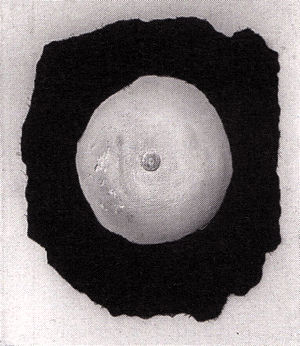
on cardboard, backed with wove paper, 24.1 x 45.2 x 1.5 cm.
It was therefore only after World War II, when utopian ambitions seemed discredited, that Duchamp’s wittily ironic work and his detached and sceptical but graciously disarming personality, were likely to have been received outside the narrow circle of his friends. It is true that the Surrealist leader André Breton had recognized his genius in 1922 (before Surrealism) and courted him incessantly thereafter; but this was at a risk, as when, in 1938, he hung twelve hundred coal-bags from the ceiling of their Paris exhibition – for “decor,” as he said dryly to Paris critic Otto Hahn, “to get a bit of gaiety in.” In fact, the Surrealist’s favourite themes of chance and sexuality had both been launched by Duchamp a decade prior to Surrealism’s existence, and when he was invited to design the catalogue cover for their 1947 post-war “comeback” show in Paris, his outrageous work, Please Touch, displayed upon it, took advantage of them for his own esoteric ends (it was one of several studies of the time that later led to his last work Etant donnés, of which more later).
At the Service of the Mind
Duchamp said in 1946 that he had sought “to put painting once again at the service of the mind,” and the exegeses that have sprung up around his work confirm that he succeeded. Not that the books are always in accord—for if there is a single key to Duchamp, it is his view that art can accommodate multiple interpretations: “People give more to pictures than they take from them,” he said in 1915, in the American journal Arts & Decoration—in an interview significantly titled “A Complete Reversal of Art Opinions by Marcel Duchamp, Iconoclast.” Indeed, by 1915, he had already ensured that this would happen in regard to his own art, by writing notes towards his various projects in such cryptic terms that they were bound to be interpreted in different ways. That he intended that the notes be read is clear, since he occasionally published some of them in replica, loose, in various “boxes,” one of which, The Green Box of 1934, was published as a book in 1960.
It is the deciphering of these obscure notes, retrieved in random order from their boxes, alongside various gnomic statements by the artist and the baffling objects that compose his oeuvre, that have generated the scholarly activity of recent years—which, at different times, has found in them a complex meditation on such themes as alchemy, courtly love, the fourth dimension, the institution of “Art,” reception theory, “desire” and gender politics, the contingent nature of the artist’s voice, the neurophysiology of vision and, pari passu, the first stirrings of Post-Modernism—when Modernism itself had scarcely found its feet.
Early Years
Born in 1887, near Rouen, Henri-Robert-Marcel Duchamp attended there one of the most prestigious of French high schools, the Lycée Corneille, where he learned Latin, Greek, and German and excelled in geometry and drawing—achievements that would help him later but which failed to gain him entry to the École des Beaux Arts. It was thus, at age nineteen, that he found himself in Paris with two older artist brothers, drawing for such ribald journals as Le Rire (Laughter) and becoming, at the age of twenty, a founding member of the new Salon des Artistes Humoristes.
It was in these bawdy journals, with their sexual and sexist innuendos, verbal puns, and visual double-entendres that some conspicuous themes in Duchamp’s art began. Asked by Pierre Cabanne what was the place of eroticism in his work, Duchamp replied, “Enormous.” He might have said the same of his sardonic humour. Both are to be found in his cartoons, but also in the works of the present exhibition, though like the “purloined letter” in the tale by Edgar Allan Poe, they have often been so conspicuous as to rest unnoticed until now—as in the case of Red Nude.
Red Nude
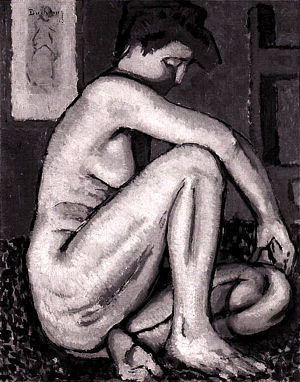
No one who sees Red Nude (in the collection of The National Gallery of Canada) can miss the baffling rendering of the nude’s left leg or the strange markings on her upper thigh—and yet this work has been persistently dismissed by every commentary with vague remarks about its “Fauvist” style. However, closer scrutiny suggests that it contains the sexual motifs perpetuated in the art of Duchamp till his death—motifs concealed by different strategies. The first of these, in regard to Red Nude, is the drawing of the nude’s left leg which seems to include a phallic reference, and the second involves the superimposition on the nude’s thigh of a second drawing, conspicuous especially after masking out the painting’s lower-right quarter when we find the single thigh becomes two thighs and a female orifice is suggested; and if, with this in mind, you turn the painting clockwise on its side you get a further scandalous effect.
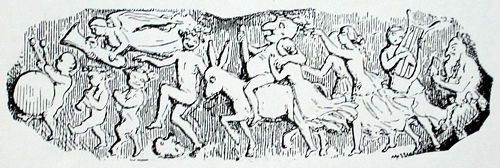
In other words, Red Nude belongs within a little-known but time-honoured subgenre of lewd, all-but-hidden, visual tricks (here illustrated with a famous image from the nineteenth century British journal Punch). But though the usual challenge in this genre is to get the work accepted by as large (and blind) a public as possible, Red Nude was owned by Duchamp’s sister, Suzanne, his co-conspirator in art, and became public only when she died in 1963. Duchamp, however, took up the challenge more than once—it is evident, for instance, in the 1967 poster Ready-mades et éditions de et sur Marcel Duchamp, which readers can decipher for themselves.

Red Nude is thus a product of the bohemian subculture of Paris in the closing decade of La Belle Epoque, when the anarchistic cabarets of Montmartre were centres of sexual licence, scatological humour, and cleverly sardonic social putdowns—all melding seamlessly with more sophisticated art forms like the sexual spoofs, outrageous plays, and “pataphysics” of Alfred Jarry, the fake philology of J.-P. Brisset, and Raymond Roussel’s bizarre novel Impressions d’Afrique, the plot of which proceeds, like Brisset’s “philology,” by homophonic plays on words (and features “art” made out of chance events by various machines). Duchamp would shortly draw from all of these, and also from the works of Lewis Carroll, translations of whose Alice books he later used in tutoring his New York friends in French.
Nude Descending a Staircase
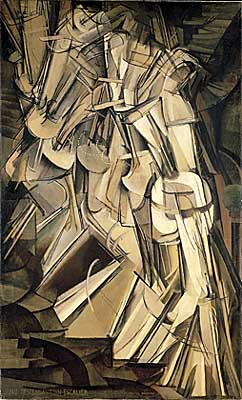
In the meantime he tested out a rapid sequence of the current “isms.” There were paintings of his sisters and other members of his family; some nudes, called “ugly” by the critic Guillaume Apollinaire (Red Nude was not among them); two paintings that relate to the human “auras” then popular among Theosophists; a 1911 painting with a statue of the Buddha (an emblem whose shape would seem to reappear in the form of a “Ready-made” called Fountain, in 1917), and some Cubistic works based on the motion-sequence photos of E.-J. Marey. It was one of these, Nude Descending a Staircase, that became a success de scandale in 1913, in the first big show of modern art in New York, when local journalists singled it out for ridicule and thus gave Duchamp, in absentia, a dizzying celebrity in America while he still remained unknown in Europe.
Enlightenment
Just prior to this, however, and quite unknown to anyone, the thought and art of Duchamp had undergone a startling transformation. The year was 1912. In Paris, Picasso and Braque were about to glue fragments of readymade pictorial materials into Cubist “still life” paintings, and Roussel was preparing a stage version of Impressions d’Afrique. In Munich, Kandinsky had begun to paint on glass and to claim that art should be confined to “colour auras” and the “stripping” or the “veiling” of material forms so as to render them subliminal. That June, Duchamp attended Roussel’s play, and then he took the train to Munich.
Much erudition has gone into trying to decide what happened next, but all we know for certain is that Duchamp returned to Paris with a new, heretical conviction—that artworks were so diverse that they could never share a common essence, be it spiritual, aesthetic, or anything whatever. Instead, he now believed they got their status not through any property inherent in them, but rather through a social ritual akin to baptism—a notion that would gain attention from professional philosophers only in the 1960s, as Duchamp’s intellectual stock began to rise. Nevertheless, it was with this new conviction that he began his art career afresh while still in Munich, with notes and studies for two extraordinary projects.
Ready-mades
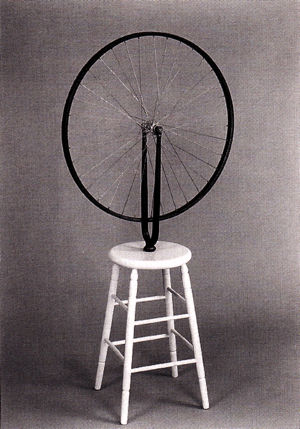
The first of these projects might be termed “concrete philosophizing.” Duchamp acquired “indifferently” some common objects that he would eventually insert into the ritual process that, he now believed, established works of art as Art. Called “Ready-mades” soon after Duchamp’s arrival in New York in 1915, the first such object, a bicycle wheel mounted on a stool, came in 1913. It evidently followed from such works as Nude Descending a Staircase, which had merely represented motion whereas the wheel embodied it. Indeed, with the Bicycle Wheel we enter as if through a door the vast terrain of the geometry of “n” dimensions uncovered during the nineteenth century by such mathematicians as Poincarré and Jouffret, with which Duchamp was so familiar that he built almost his entire oeuvre upon it (as the art historian and mathematician Craig Adcock has shown). As an elementary example of this, the wheel can be seen as demonstrating (in Euclidean terms) the geometric sequence of a zero dimensional ‘point” (like the end of a spoke) extended to create a one-dimensional line (the actual spoke), the sideways movement of the spoke/line to form a two dimensional plane (as the wheel rotates on its axis) and a three dimensional sphere if at the same time that it rotates on its axis it also rotates on its shaft. Duchamp once even suggested a system based on a parallel of the bicycle wheel and the Roulette wheel which might turn such gambling into a game of chess (confident of his international reputation as a chess player); but although he offered shares in this venture he does not seem to have prospered, and it may be seen as a parallel of “playing” the art world, though it has never been completely understood. Meantime, others have been content to point out that the words wheel-stool, by stretching French a little, give roue-selle, the linking of which would certainly have pleased him for the resonance with “Roussel” (the author already mentioned).

It was not until 1917, however, that Duchamp got the chance to state the case for his “Ready-mades” in public—in a pamphlet published specially for that purpose and called with heavy irony “The Blind Man.” This slim publication coincided with a New York art event that he had helped to stage: “The Society of Independent Artists Exhibition,” to which he secretly contrived to send a work that he called Fountain—an upturned men’s urinal signed with the pseudonym “R. Mutt.” Predictably, it caused an up-roar and was spirited away before the exhibition opened. And equally predictably, its photo had been taken on Duchamp’s behalf and was published in “The Blind Man” pamphlet—whose supposed editorial committee wrote: “Whether Mr. Mutt with his own hands made the fountain or not has no importance. He CHOSE it. He took an ordinary article of life, placed it so that its useful significance disappeared under the new title and point of view—created a new thought for that object.” In other words, the object was not changed, but given a new context such that the viewer’s attitude towards it was changed, consistent with Duchamp’s earlier statement in Arts & Decoration, mentioned above. It should be added that in the early years of the present century an international poll of artists, critics and museum curators voted Fountain the most important artwork of the twentieth century although they had never seen the original.
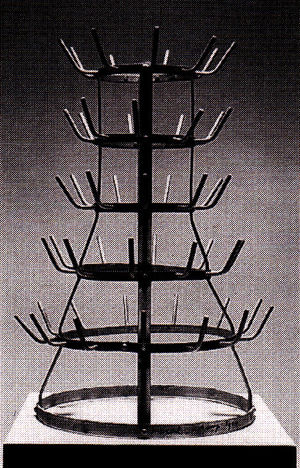
There had been other “Ready-made” art objects prior to Fountain, including the hilarious Snow Shovel, inscribed “IN ADVANCE OF THE BROKEN ARM,” which was the first Ready-made to be chosen after Duchamp had coined the term; though before that, while he still lived in France, there had been a Bottle Dryer: called in French an égoutoire (drainer), since it drains away the gouttes (the drops of water left from rinsing out a bottle), and this, as Pontus Hulten has pointed out, is homophonic with the draining-off of “gout,” or taste, as if to remind us of the artist’s assertion that the Ready-mades had been chosen out of “visual indifference,” not taste. Indeed, decades later, when Alfred Barr, director of the Museum of Modern Art in New York, insisted that the Bottle Dryer, even so, was beautiful, Duchamp’s dry response was, “Well, we can’t all be perfect!” (There is more to this exchange than meets the eye, however, since shortly after Munich, before his insight into Readymades had fully crystallized, Duchamp himself had held that aeroplane propellers were superior to sculpture—a taste judgment that he quickly put behind him but which, in the hands of others, was to become the utopian “machine aesthetic” of the 1920s. This aesthetic Barr himself had served, as a museum director, and was evidently still defending.)
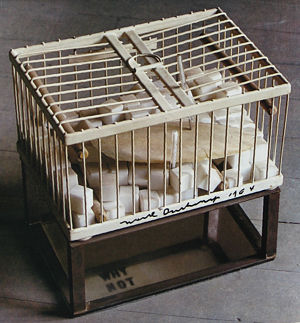
Duchamp also invented the notion of “Assisted Ready-mades,” anticipating what today we call “assemblage.” For instance, he “assembled” 152 marble “sugar” cubes in a cage with a thermometer and a cuttlebone and called the whole thing Why Not Sneeze Rose Sélavy? This product was a response to the sister of one of his wealthy friends, Katherine Dreier, who had asked him to “make something” for her! The vulgar, orgastic implication of “sneeze” may have been Duchamp’s comment on the calculated vulgarity of her request; it certainly diverted attention from some cryptic numerology within the work—since it has only recently been noticed, by Hubert Damisch, that 152 is a number anagram of 512 (the number obtained by cubing the two-dimensional chessboard). In this way the cubes relate to those shown in the etching The King and the Queen, which was originally the poster for a chess tournament, made from the photo of a set of building blocks suspended randomly in netting. The blocks, in turn, remind us of the illustrations found in popular texts of that period, concerning n-dimensional geometry, where it was sometimes argued rather mystically that our three-dimensional world was a shadowy projection of a world of four dimensions.
“The Large Glass”
The second of the projects conceived in Munich was in direct contrast to the effortless production of the Ready-mades. It was to be called La Mariée mise à nu par ses célibataires, même (“The Bride Stripped Bare by Her Bachelors, Even”), a title that reminds us not only of Kandinsky’s thoughts on “stripping,” (see “Enlightenment,” above) but also of the peep-shows in amusement arcades, and even allegorical images in medieval alchemy. A vastly complex work, accompanied by many cryptic notes, it attempts to reinstate in multi-layered form the allegorical method that the modern “isms” had discarded. On one such level it would be an allegory of the state of painting as Duchamp saw it after his “illumination” (his Preface to the notes speaks of “the allegorical appearance of a succession of various facts”). The work, he said, should not be viewed without these notes in hand, in order to maintain a balance between the conceptual and the visual.
At first conceived on canvas, it was soon to be subtitled “A Delay in Glass,” and its support was changed from canvas to glass, the notes implying that the artist had in mind the stand-in for a monster photographic plate (for instance, in 1914, he was to publish sixteen of the notes in a Kodak box, photographed and mounted on cards the size of actual plates).
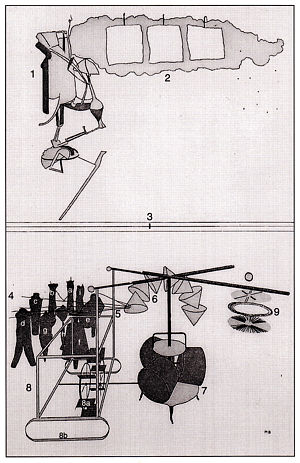
- The Bride’s Domain: Upper Section
- 1. The Bride (pendu femelle)
- 2. Milky Way
- 3. Horizon
- The Bachelor Apparatus:
- Lower (Cemetery) Section
- 4. Nine Bachelors (also called Malic Moulds)
- a. Priest
- b. Delivery Boy
- c. Gendarme
- d. Cuirassier (Cavalryman)
- e. Policeman
- f. Undertaker
- g. Flunky (Liveried Servant)
- h. Busboy
- i. Stationmaster
- 5. Nine Capillary Tubes
- 6. Seven Sieves
- 7. Chocolate Grinder
- 8. Chariot or Sleigh
- a. Water Mill Wheel
- b. Glider
- 9. Oculist Witnesses
“The Large Glass,” as it thus came to be called, was to have an upper section for the “bride” and a lower section, or “cemetery,” for nine voyeuristic “bachelors.” This upper/lower schema may have been adopted from traditional portrayals of both The Assumption of the Virgin and The Triumph of Venus (there is mention in the notes of “the apotheosis of virginity”), but it might have been adopted also from a passage in Roussel’s Impressions of Africa, where almost the exact same format had appeared in the description of a picture realized in “molded smoke!”
“The Large Glass,” however, is as much a diagram as a depiction: the notes show it cast mockingly in terms of an immobilized Rube Goldberg machine that will splutter into action as the “bachelors,” behaving like automata, emit “illuminating gas.” This gas, the artist says, will be transmitted through “capillary tubes” before it changes its material state to solid and then liquid—when it splashes upward to the “bride’s domain,” inciting her response. The “bride,” he says, will have a “motor with quite feeble cylinders,” fuelled with “love gasoline.” Such are mere fragments of the multi-level cipher whose key was not to be released in its entirety within the artist’s lifetime.
It was no accident that Duchamp’s chief supporter in the United States was Walter Arensberg, who had created the foundation to search Shakespeare for the ciphers that would prove that Francis Bacon had written the plays. Indeed, in French, the long title of the work is itself a cipher that contains the name “Marcel,” partly in the female “Mariée” and partly in the male “Célibataires.” Are we then looking at an allegory of the narcissistic artist (the fictional “Mar-Cel” at once the active viewer and the passive viewed), or at the artist as androgynous producer (anticipating his creation of a female alter ego some years later)? Or does “Mar-Cel” imply a poignant separation of the artist from the artist’s aims (the Judeo-Christian “Fall” from androgynous perfection into a state of “desire” to return there—as Plato had suggested)? Considered as a multi-level allegory, the answer surely is “all three,” although “desire” (a function of “delay”) was to become the most elaborated theme.
The allegories build, like Roussel’s play and Brisset’s philology, by verbal and visual puns and, like Jarry’s “pataphysics,” by bizarre equations; and their execution proceeds by a quixotic mixture of chance methods and painstaking labour. For instance, in the lower (earthly), three-dimensional bachelors’ domain, we find immaculately skilful perspective renderings of the elements called “oculist witnesses” and “seven sieves,” and yet the colour of the “sieves” is derived from allowing dust to accumulate, or “breed,” upon the surface of the glass, where it was fixed with varnish—just as light impacting on a photographic plate is “fixed”—both equally the index of a “time exposure”).
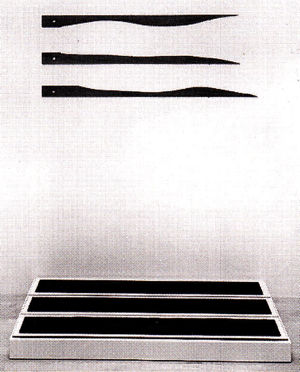
There are other instances of chance combined with “indexical” procedures—for example, in the perspective rendering of the nine “capillary tubes,” which would first be drawn in plan—by using three misshapen metre rules, called “standard stoppages,” made from templates formed by dropping metre lengths of thread and gluing them to canvas where they “stopped.”
The then fashionable references to the “fourth dimension” are found (in accord with Kandinsky’s theosophical writings) only in the heavenly domain of the dematerialized “bride,” above whom hovers a cloud into which the Virgin was traditionally received. This cloud, however, is called by Duchamp “The Milky Way,” which has never been recognized as the term used among French schoolboys to refer to their nocturnal emissions – yet this seems to have been clearly intended by the context of frustrated “bachelors,” and by the fact that Duchamp later used his own semen for a pictorial purpose. The bizarre image of the “bride” seems to be presented, to use Kandinsky’s terms, in “a more denuded form of construction.” Looking something like a praying mantis, this strange female figure was taken from a painting that Duchamp had made in Munich called The Bride, which may itself have been derived from a painting of his sister Magdeleine precisely via Kandinsky’s “stripping” process. The “bride” is also referred to in the notes as Le pendu femelle (“the hanged female thing”), perhaps because in the French language a painting (une peinture) is of feminine gender and is “hung.” At this point we might well be hearing Lewis Carroll, except that Duchamp uses the French “pendu,” which is masculine, and thus for some interpreters inducts the “bride” into a larger esoteric discourse that involves The Hanged Man of the Tarot deck. The viewer evidently has an interactive choice!
Meta-irony

Duchamp abandoned The Large Glass as “inachevé” (“definitively unfinished”) in 1923. Nevertheless, it was exhibited in 1926 at the Brooklyn Museum—only to be smashed to fragments on its journey back, and to lie ten years untouched (and even unopened) until the artist needed to restore it so that he could photograph it for another project, The Box in a Valise. It was then that the artist’s principle of “meta-irony” (the co-opting of chance events) came once more into play, when he decided that the smashing of the work had been exactly what was needed to complete it—and in its now no longer “virgin” state, with every shard restored in place by Duchamp, his wealthy friends looked after it until its final placement in the Philadelphia Museum of Art, in 1954.
Rotoreliefs
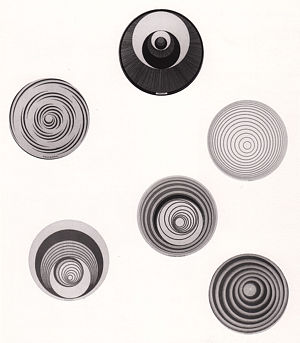
In spite of earlier statements, Duchamp created one last painting, in 1918, for his friend and supporter Katherine Dreier, called Tu m’ (discussed elsewhere on this site), and, after that, excursions into stereoscopy that produced, among other things, the so-called Rotoreliefs. According to the artist, these remarkable devices were conceived in 1920, though the earliest known schematics are dated 1923 and David Piggins has noted that in 1924 an exactly similar “stereo-kinetic effect" was extensively discussed by the Italian psychologists Benussi and Musatti. Made visible only when the discs are put in motion on a turn-table, their illusory third dimension and libidinous rhythm are most evident when looked at with one eye; indeed, they represent the only means by which a person born blind in one eye can gain insight into what it means to perceive the world visually in three dimensions.
Unlike monocular perspective and anamorphic images, which remind us of the era when perception was conceived as passive, experiments in stereoscopy make it clear that visual perception involves an active neural process of selecting and interpreting the stimuli that hit the retina. They thus sustain from a new angle Duchamp’s view that people give to pictures more than common sense allows.
Rrose Sélavy
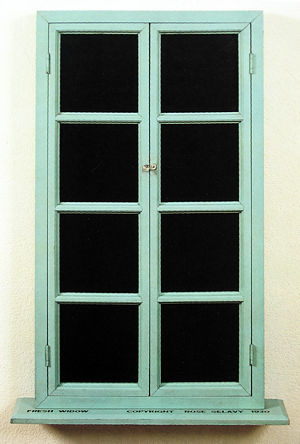
If such optical investigations seem more scientific than artistic, it may explain why, in 1919, Duchamp had begun to call himself an “engineer,” perhaps mocking Leonardo on the quadricentennial of the latter’s death, since it was also at this time that he drew the famous van Dyck beard on a postcard of the Mona Lisa. Taking this self-redefining even further, he then inscribed “Copyright Rose Sélavy” upon a work that he called, punningly, Fresh Widow—a miniature French window whose panes he covered with black leather as if to indicate a drawn-down blind (discussed elsewhere on this site). A feminine persona was thus added to the Duchamp oeuvre, and though there is no record of his ever publicly cross-dressing, he was photographed to amplify the fact in hats and coats belonging to his women friends. Later, he added a second “R” to the beginning of this name (making it “Rrose”) so that its pronunciation sounded like “Eros” and the entire name became a double entendre sounding like the phrase “Eros, c’est la vie.” This fluctuant identity, from artist to engineer, from male to female, may be said to have begun in 1912, with “Mar-Cel,” as we have already noted. However, by 1919, Duchamp’s narrow escape from a devastating patriarchal war seems to have enlarged his awareness of the gendered politics of art production (of “mastery”), such that “Rose” or “Rrose” would further open up the claim, which “Mar-Cel” had already staked, for the contingent identity of every author. It may also be seen, as Amelia Jones has pointed out, as an early attempt to dismantle the binary, male/female, logic of gender, where “male” is seen as dominant – something that qualifies Duchamp as the earliest of post-modern thinkers. It has also been shown, by Craig Adcock, that such a making-over of the self can even be reformulated in the terms of four-dimensional geometry!
Later Years
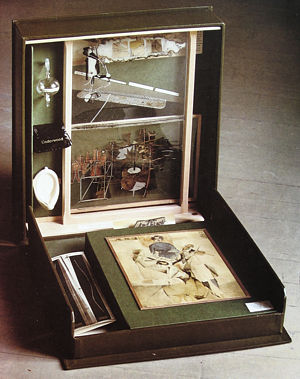
With “Rose” (or “Rrose”) to play the artist-engineer throughout the next decades, Marcel was freed to gain celebrity in international chess and also to play the role of art consultant—a role which he decided to affect towards himself in 1936, with the conception of a portable museum that he proposed to call The Box in a Valise. This curious production is literally a box, with stand-up flanges inside, originally containing sixty-nine miniatures of Duchamp’s most important works up to 1936. That it needed a “valise” in which it could be carried may have been because “valise” turns out, in both French and English, to be an anagram of “selavi!” It opens somewhat like an altarpiece, but also like a traveling salesman’s sample case, and even suggests a portable, collapsible museum or eighteenth-century “curiosity cabinet” (that collection of assorted items, like the Ready-mades, where the “new thought for that object” might be said to have begun in the late 17th century).
To have been issued in an edition of 300, what is notable about the Box and its contents, and what has only recently been uncovered by historian Ecke Bonk, is that at a time when, say, Picasso’s paintings seemed to get “knocked off” in hours or days, Duchamp’s handcrafted project took five years; and while he allowed it to be thought that he had used commercial reproductive processes, Bonk has shown that, to reproduce Nude Descending a Staircase and much else, Duchamp and his assistants used forty different hand-applied colour stencils—a marvel of the artisanal tradition which explains the five years of its making.
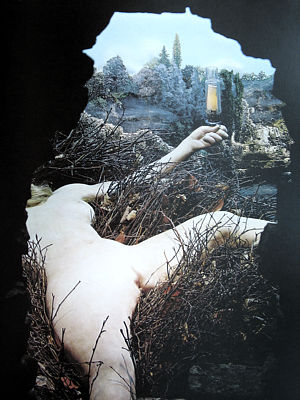
“Rrose” also signified that the erotic in its various guises would continue as a leitmotif throughout Duchamp’s work until he died. For although he was believed to have retired from art with the production of The Box in a Valise (a “defrocked artist,” as he put it), he set about secretly constructing a second, dioramic version of “The Large Glass,” which took him 20 years and was installed at the Philadelphia Museum of Art only after his death. The name of this last work, Etant donnés (“Being given”), repeats a parody of Euclid with which he had begun his “Preface” to the notes of 1912. In it, in contrast to her treatment in “The Large Glass,” the “bride” is literally “stripped bare” and realized life-size, in three dimensions, as well as posed so as to make conspicuous the genitalia that first appeared so disingenuously in Red Nude.
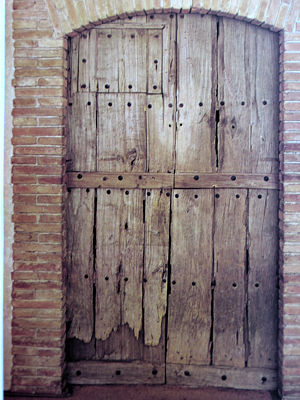
However, now the viewer is forcibly discomforted upon discovering the taboo image—for in The Philadelphia Museum it must be looked at through a peep-hole in a door while other museum visitors regard the viewer’s back and count the time s/he takes. Duchamp married the divorced wife of Pierre Matisse in 1954 and from then onwards spent annual holidays in Spain near Cadaqués (the home town of Salvador Dali) where he eventually bought the door seen here and shipped it to the States. Not only that but the couple also bought the bricks that surround the door, transporting them across the Atlantic, a few each year, in their luggage—another example of Duchamp’s sublime indifference to time passing, even as it brought him nearer to his death.
The artist’s death in the early morning of October 2nd 1968 also recalled the period of Red Nude, for Duchamp died suddenly while laughing at a passage in a book by Alphonse Allais, a comic writer of the Belle Epoque. His epitaph reads D’ailleurs, e’est toujours les autres qui meurent (“Besides, it’s always other people who die”). There was a dispute with the authorities before the epitaph could be engraved on the family tombstone.
Selected Bibliography
- Adcock, Craig: Marcel Duchamp’s Notes from the Large Glass: An N-Dimensional Analysis. Ann Arbor: U.M.I. Research Press, 1981.
- Bonk, Ecke. Marcel Duchamp: The Box in a Valise. New York: Rizzoli, 1989.
- Cabanne, Pierre. Dialogues with Marcel Duchamp. New York: Viking, 1971.
- Clair, Jean, and Linde, Ulf : Abecedaire / Approches critiques. Paris: Musée National d’Art Moderne, 1977.
- D’Harnoncourt, Anne, and McShine, Kynaston, eds. Marcel Duchamp. New York: Museum of Modern Art, 1973.
- de Duve, Thierry, ed: The Definitively Unfinished Marcel Duchamp. Cambridge, Mass. and Halifax Nova Scotia: MIT Press and Press of the Nova Scotia College of Art and Design, 1991.
- Hulten, Pontus, ed.: Marcel Duchamp (with texts by Jacques Caumont and Jennifer Gough-Cooper. London: Thames and Hudson, 1993.
- Jones, Amelia. Postmodernism and the Engendering of Marcel Duchamp. Cambridge: Cambridge University Press, 1994
- Kuenzli, Rudolf E., and Francis Naumann, eds. Marcel Duchamp: Artist of the Century. Cambridge, Mass: MIT Press, 1989.
- Saisselin, Rémy G. Taste in Eighteenth Century France: Critical Reflections on the Origins of Aesthetics. Syracuse: Syracuse University Press, 1965.
- Sanouillet, Michel, and Peterson, Elmer, eds. Salt Seller: The Writings of Marcel Duchamp. New York: Oxford University Press, 1973.
- Schwarz, Arturo. The Complete Works of Marcel Duchamp. New York: Abrams, 1970.
